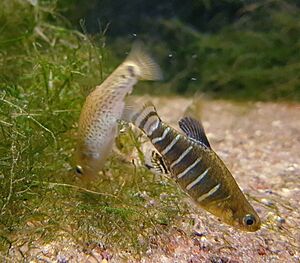Kızılırmak toothcarp facts for kids
Quick facts for kids Kızılırmak toothcarp |
|
|---|---|
 |
|
| Anatolichthys danfordii (male right, female left) | |
| Conservation status | |
| Scientific classification | |
| Synonyms | |
|
The Kızılırmak toothcarp (scientific name: Anatolichthys danfordii) is a small fish. It is a type of killifish from the Cyprinodontidae family. This fish lives only in Turkey. You can find it in the Kızılırmak River and the upper Seyhan River areas. Now, it mostly lives in the Sultan Sazlığı marshes. Sadly, there are fewer and fewer of these fish. Experts say it is "critically endangered". This means it is at high risk of disappearing forever if its home continues to dry up.
Contents
Where It Lives
The Kızılırmak toothcarp lives only in Turkey. It can be found in the river systems of the Kızılırmak River. It also lives in the upper parts of the Seyhan River. More research is needed to find all the places it lives.
What It Looks Like
The Kızılırmak toothcarp looks different depending on if it's a male or a female. This is called sexual dimorphism.
Males have nine to twelve dark stripes on their sides. Their top fin, called the dorsal fin, is dark blue-black. Their tail fin and bottom fin (anal fin) are usually clear or yellow. These fins also have two or three black lines on their edges.
Females have a shiny, silver-grey body. They have many dark grey spots. The biggest spot is always right at the base of their tail fin. All of their fins are clear, without much color.
Its Home
The Kızılırmak toothcarp lives in several types of watery places. It likes small springs and swamps. It also lives in marshes and quiet parts of streams. These places are important for its survival.
Life Cycle and Habits
The Anatolichthys danfordii is not a seasonal fish. This means it lives for more than one year. It can live for up to five years.
This fish has a long time when it lays eggs. This period lasts from May until the end of August. Its eggs are sticky and attach to water plants. They are laid in small groups. The fish grows quickly and lays many batches of eggs. This helps it survive well in its environment.
Why It's in Danger
The Sultan Sazlığı marshes are drying out. These marshes are in a place called Develi. People are taking water from the marshes for farming. This means there is less water for the fish to live in.
The International Union for Conservation of Nature says this fish is "critically endangered". They are worried it might disappear from the wild. This could happen if the marshes keep drying up.
How It Got Its Name
Anatolichthys danfordii was first described in 1890. A scientist named George Boulenger gave it the name Lebias danfordii. He found it near a place called Albistan.
The second part of its name, danfordii, honors someone special. It is named after Charles George Danford. He was a Scottish artist and sportsman. He was also an expert on birds. Mr. Danford was the one who collected the first fish of this type.
See also
 In Spanish: Aphanius danfordii para niños
In Spanish: Aphanius danfordii para niños


